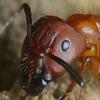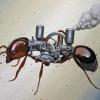- Formiculture.com
- Forums
- Gallery
- Members
- Member Map
- Chat

Pogonomyrmex Stingers
Started By
AntswerMe
, Jul 1 2017 12:21 PM
14 replies to this topic
#1
 Offline
-
Posted July 1 2017 - 12:21 PM
Offline
-
Posted July 1 2017 - 12:21 PM
Hey, I have been stung by Florida harvester ants (Pogonomyrmex badius) on multiple occasions (and yes, it hurts A LOT) and have noticed something worth noting. When an ant stings me or something else, it appears it's entire stinger and a piece of some kind of bright orange tissue behind it is expelled from the ant, and is stuck into what it is stinging. What happens to the ant afterwords? It apparently doesn't have a stinger any more, does it? If gone, does the ant grow another stinger, or does it die? What happens?
#2
 Offline
-
Posted July 1 2017 - 2:13 PM
Offline
-
Posted July 1 2017 - 2:13 PM
The ant dies.
- Martialis likes this
#3
 Offline
-
Posted July 1 2017 - 2:24 PM
Offline
-
Posted July 1 2017 - 2:24 PM
If so, them the queen I caught is done for, as it stung the cloth I caught it with. I caught another queen soon after without it stinging anything, so that's good.
#4
 Offline
-
Posted July 1 2017 - 3:17 PM
Offline
-
Posted July 1 2017 - 3:17 PM
I thought semi-clausteral species, such as Myrmica, have stingers to seduce prey and feed to the brood? They don't die after an attack?
Hit "Like This" if it helped.
#5
 Offline
-
Posted July 1 2017 - 3:36 PM
Offline
-
Posted July 1 2017 - 3:36 PM
I didn't think any ants lost their stingers.
Then again, I've only been stung by a handful of different species (Solenopsis, Tetramorium, Pseudomyrmex).
Then again, I've only been stung by a handful of different species (Solenopsis, Tetramorium, Pseudomyrmex).
#6
 Offline
-
Posted July 1 2017 - 6:50 PM
Offline
-
Posted July 1 2017 - 6:50 PM
I seem to recall that the stingers of Pogonomyrmex are barbed to varying degrees, In extreme cases the stingers can pull out of the body as in honey bees, if this occurs they die.
Edited by gcsnelling, July 1 2017 - 6:51 PM.
#7
 Offline
-
Posted July 1 2017 - 7:47 PM
Offline
-
Posted July 1 2017 - 7:47 PM
I recall an article I recently read; it's not entirely on-topic although it's close enough. It's titled Evolution of the Sting Apparatus in the Myrmicine Ants. The diagrams were particularly interesting to me.
https://www.research..._Myrmicine_Ants
http://onlinelibrary....tb04668.x/full
https://www.jstor.or...an_tab_contents
These are the onlune libraries, though you should be able to make an account.
Edited by Martialis, July 1 2017 - 8:18 PM.
- gcsnelling likes this
Spoiler
#8
 Offline
-
Posted July 2 2017 - 11:12 PM
Offline
-
Posted July 2 2017 - 11:12 PM
gcsnelling The stingers to seem to have very small barbs as when I see an ant sting something, the tip of the stinger stays put into the victim and if the stinger is deep enough in, will stick and completely pull out of the ant, like honey bees. I didn't know any ants did this though. I would assume an ant that lost it's stinger and whatever the stinger was connected to would die.
Edited by AntswerMe, July 2 2017 - 11:12 PM.
#9
 Offline
-
Posted July 2 2017 - 11:19 PM
Offline
-
Posted July 2 2017 - 11:19 PM
I recall an article I recently read; it's not entirely on-topic although it's close enough. It's titled Evolution of the Sting Apparatus in the Myrmicine Ants. The diagrams were particularly interesting to me.
https://www.research..._Myrmicine_Ants
http://onlinelibrary....tb04668.x/full
https://www.jstor.or...an_tab_contents
These are the onlune libraries, though you should be able to make an account.
Stumbled on a PDF version of above mentioned article a few weeks ago. Thank god I bookmarked it ![]()
http://www.antwiki.o...micine_Ants.pdf
Edited by LC3, July 2 2017 - 11:19 PM.
- Martialis likes this
#10
 Offline
-
Posted July 3 2017 - 3:13 AM
Offline
-
Posted July 3 2017 - 3:13 AM
gcsnelling The stingers to seem to have very small barbs as when I see an ant sting something, the tip of the stinger stays put into the victim and if the stinger is deep enough in, will stick and completely pull out of the ant, like honey bees. I didn't know any ants did this though. I would assume an ant that lost it's stinger and whatever the stinger was connected to would die.
Yup, stinger pulls out and the ant dies.
#11
 Offline
-
Posted July 3 2017 - 8:28 AM
Offline
-
Posted July 3 2017 - 8:28 AM
Wait what? Seducing prey? Considering the amount of times I've been stung, I don't think they die after a sting eitherI thought semi-clausteral species, such as Myrmica, have stingers to seduce prey and feed to the brood? They don't die after an attack?
Visit us at www.canada-ant-colony.com !
#12
 Offline
-
Posted July 3 2017 - 11:56 AM
Offline
-
Posted July 3 2017 - 11:56 AM
Obviously, he meant subdue. The barb must vary by species, as Mr. Snelling indicated. I have been stung by Pogonomyrmex and others and have never seen this phenomenon. Very interesting, I thought that ants and wasps lacked barbs and would survive is they stung a vertebrate.
#13
 Offline
-
Posted July 14 2017 - 6:58 AM
Offline
-
Posted July 14 2017 - 6:58 AM
The Pogonomrymex badius do loose their stingers when they do get agitated enough to actually sting. But they do not die anytime soon.... I have been stung a plenty by them... and noticed that when the stinger is lost the ant seems to loose some of the gaster. i will video this for you all and show you how the gaster heals and the ant lives on...I will make a thread titled "OUCH"
#14
 Offline
-
Posted July 26 2017 - 6:43 PM
Offline
-
Posted July 26 2017 - 6:43 PM
Okay Jamie. That would be great, except for the pain! :-)
#15
 Offline
-
Posted July 26 2017 - 10:13 PM
Offline
-
Posted July 26 2017 - 10:13 PM
I've been stung too many times for comfort by Pogonomyrmex Californicus colonies (Maybe because I sometimes stumble up to their mounds without noticing? Who knows, hahahaha). Sometimes their guts and stingers stay in my leg, other times I can swipe them off without that happening.. All depends on how deep they get it.
Edited by Shaye, July 26 2017 - 10:15 PM.
A question that sometimes drives me hazy: am I or are the others crazy?
1 user(s) are reading this topic
0 members, 1 guests, 0 anonymous users





















